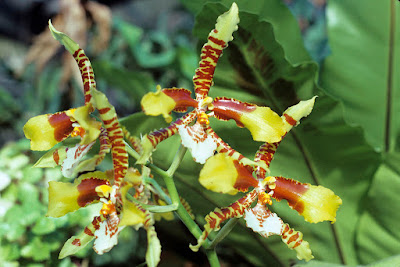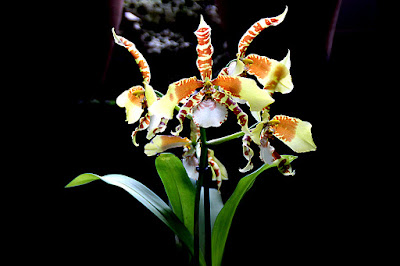Rossioglossum grande is native to Guatemala, near the city of Guatemala, at altitudes up to 2600 m above sea level. The plant was discovered in dark ravines near the city of Guatemala, then in other places...
Rossioglossum grande also called as The Large Rossioglossum, The Clown Orchid, Odontoglossum grande, Rossioglossum grande, Rudolf Schlechter, Rossioglossum grande var. aureum, is a species of the genus Rossioglossum. This species was described by Leslie Andrew Garay & George Clayton Kennedy in 1976.
IDENTIFY ROSSIOGLOSSUM GRANDE
Rossioglossum grande is native to Guatemala, near the city of Guatemala, at altitudes up to 2600 m above sea level. The plant was discovered in dark ravines near the city of Guatemala, then in other places, but always where temperatures are in the range of 15-20 ° C, and locations are constantly high in humidity and shadow. These plants were also found in Mexico, Chiapas.
It is a medium to large sized, epiphytic, warm to cold growing orchid, which reaching up to a height of 48 cm, with clustered, ovoid or orbicular, laterally compressed, ancipitous, glaucous, 10 cm high and 6.4 cm wide pseudobulbs carrying 1 to 3 apical, elliptic or lanceolate, coriaceous, glaucous, acute, petiolate, 38 cm in length and 7.6 cm in width leaves.
The Large Rossioglossum blooms on an axillary, lateral to erect, to 30 cm long, racemose, 2 to 8 flowered inflorescence with lanceolate, apressed, scarious bracts and waxy long-lasting flowers all occurring in the late fall and winter. The flowers are broadly spread and may be over 15 cm in diameter. They have a waxy texture and, if they do not come into contact with water, they can last for a month or longer. The outer whorls are yellow with wide red transverse stripes and spots. The inner whorls are light-yellow with a reddish lower part. The lip is white or creamy-white with matte red spots.
ROSSIOGLOSSUM GRANDE CARE AND CULTURE
Cultural information should only be used as a guide, and should be to be adapted to suit you. Your physical location; where you grow your plants, how much time you have to devote to their care, and many other factors, will need to be taken into account. Only then can you decide on the cultural methods that best suit you and your plants.
Light:
Rossioglossum grande needs a light level of 15000-20000 lux. The light level is slightly below the average level for Cattleya and almost the same as for most Paphiopedilum.
Temperature:
It is a plant with moderate thermal requirements. In summer, the average day temperature is 22-23 ° C, at night 12-14 ° C, with a daily amplitude of 9-11 ° C. The average winter temperature is in the day 20-21 ° C, at night 9-10 ° C, the daily difference is 9-12 ° C.
Humidity:
The Large Rossioglossum needs the humidity of 75-80% for most of the year.
Substrate, growing media and repotting:
The majority of those cultivating Rossioglossum grande recommend as a medium a bark of small or medium granulation with the addition of humectants and cultivation in plastic pots. You can repot after observing the growth of new roots.
Watering:
Watering should be abundant during active growth from late spring to early autumn. The precipitation scheme is wet / dry.
Fertilizer:
During the active growth, the plants should be fertilized every week 1/4-1/2 of the recommended dose of fertilizer for orchids.
Rest period:
In the autumn, the amount of water supplied for Rossioglossum grande should be reduced, watering lightly once every two or three weeks, and occasionally misting between these watering. During 2-3 winter months, the amount of water should be limited to occasional fogs to prevent pseudobulbs from wrinkling. Watering should be stopped until the growth of new increments begins. In winter, you should also reduce or eliminate fertilization.















COMMENTS